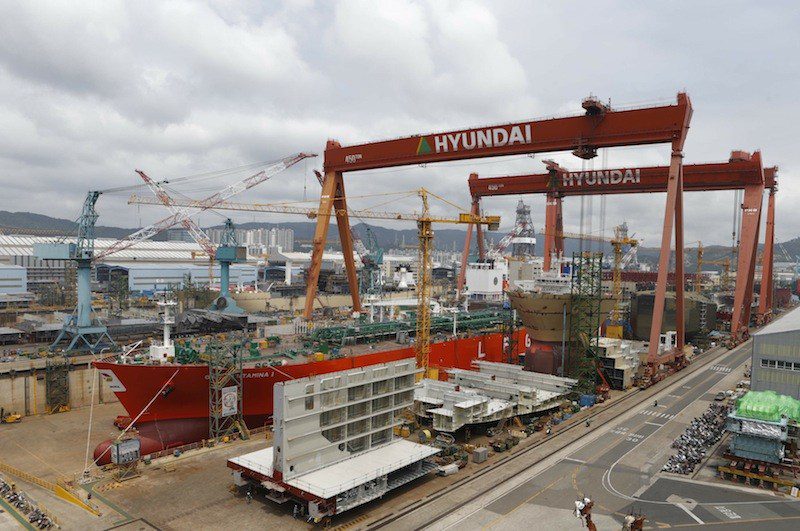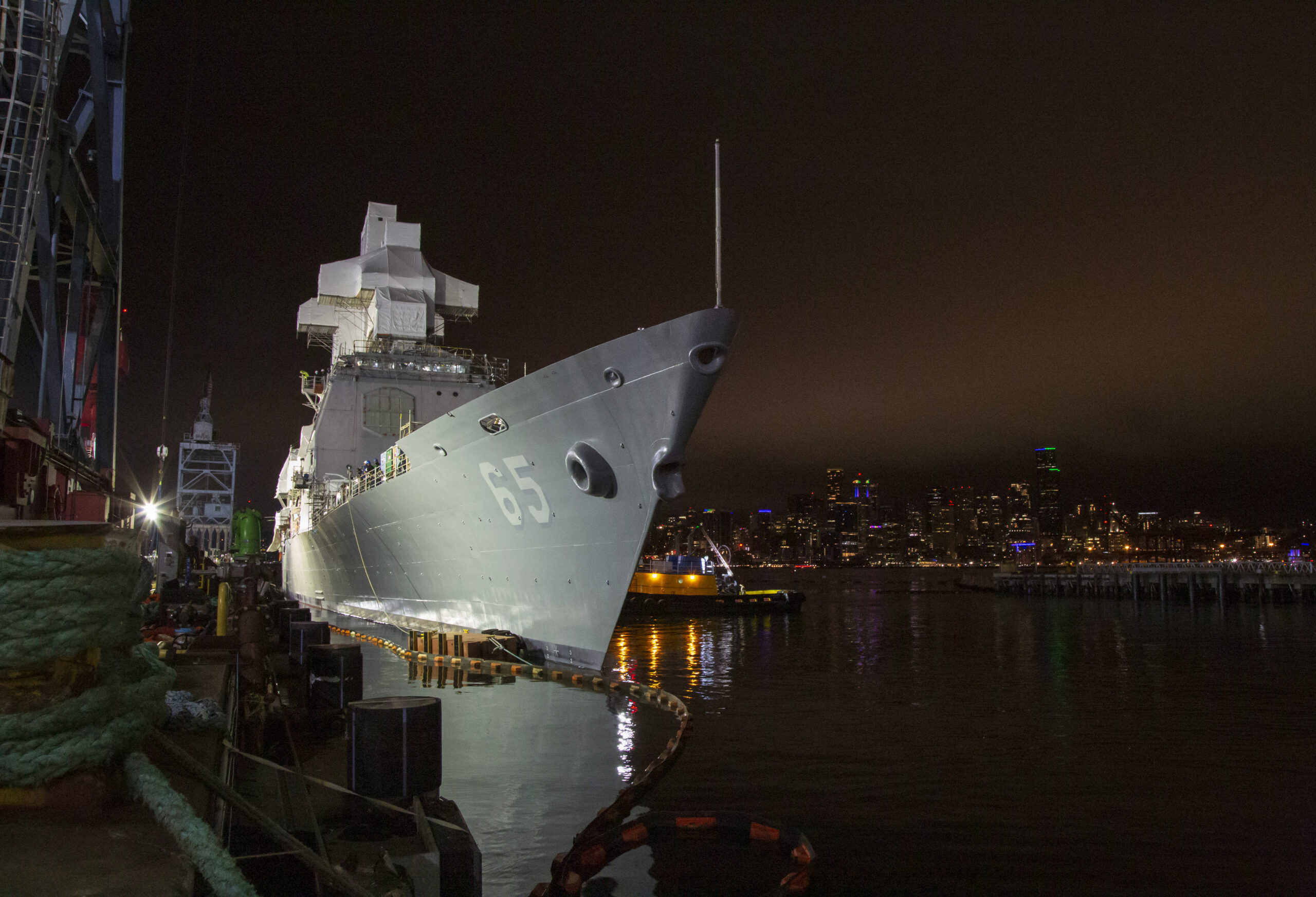President Trump has signed an executive order on Wednesday aimed at revitalizing the domestic maritime and shipbuilding industries, including in the both the commercial and military sectors.
The initiative comes as U.S. shipbuilding capabilities have fallen dramatically behind China, with American shipbbuilders producing just 0.2% of the world’s ships compared to China’s 74%.
“We’re going to be spending a lot of money on shipbuilding. We’re way, way, way behind,” Trump stated from the Oval Office.
The executive order, titled Restoring America’s Maritime Dominance, establishes a comprehensive Maritime Action Plan (MAP), which is described as a coordinated strategy designed to strengthen U.S. maritime industries. A key component includes the creation of a Maritime Security Trust Fund, serving as the financial backbone of the plan, and a financial incentives program to stimulate private investment in domestic shipbuilding.
Current statistics paint a stark picture of China’s dominance in maritime manufacturing. The U.S. produces none of the containers used in global commodity transportation, while China manufactures 96%. Similarly, China builds 80% of ship-to-shore cranes used in U.S. ports, with no domestic production.
“We used to make so many ships. We don’t make them anymore very much, but we’re going to make them very fast, very soon. It will have a huge impact,” Trump stated.
Matthew Paxton, President of the Shipbuilders Council of America (SCA), expressed strong support for the initiative: “The establishment of a strategic commercial fleet program, along with new tax credits, grants, and strategic investments, will provide a powerful environment to rebuild our shipbuilding capacity and build the fleet of the future.”
The order addresses several critical areas, including directing the United States Trade Representative to tackle China’s anticompetitive practices in the shipbuilding sector. It takes direct aim at foreign competition by proposing tariffs on Chinese-made cranes and other cargo equipment under Section 301. It also aims to prevent the circumvention of Harbor Maintenance Fees through Canada or Mexico, ensuring proper revenue collection for maritime industry investments.
A key strategic element includes the implementation of Maritime Prosperity Zones, modeled after previously successful Opportunity Zones.
A new Office of Maritime and Industrial Capacity has been established at the National Security Council in the White House to oversee these initiatives. The order also includes provisions for expanding mariner training and education through investment in the U.S. Merchant Marine Academy.
Industry response has been positive. Eastern Shipbuilding Group, a Florida-based shipyard, welcomed the order, emphasizing its importance for America’s economic prosperity and security. The American Maritime Partnership highlighted the significance of maintaining a U.S.-flagged fleet built by American workers.
The order also addresses Arctic maritime security, with plans to develop strategies for securing Arctic waterways amid increasing foreign presence in the region. Additionally, it directs the Secretary of Defense to review and provide guidance on maintaining a robust inactive reserve fleet for military operations.
Maritime Action Plan
The Maritime Action Plan is the centerpiece of the Executive Order—a coordinated strategy to rebuild America’s shipbuilding might and reestablish its position as a global maritime power.
According to a draft EO seen by gCaptain, the action plan is a strategic, whole-of-government roadmap directed by the President to revitalize America’s maritime industrial base, grow the U.S.-flagged commercial fleet, and strengthen maritime national security.
The MAP is to be developed within 210 days by the Assistant to the President for National Security Affairs (APNSA) in coordination with key cabinet agencies—including Defense, Transportation, Commerce, Homeland Security, and Labor—and the Office of Management and Budget (OMB). It will consolidate policy, budget, regulatory, legislative, and industrial recommendations outlined in the order into a single actionable document to guide long-term implementation.
Maritime Security Trust Fund
The Executive Order calls for the creation of a Maritime Security Trust Fund—a dedicated, reliable funding source that will serve as the financial backbone of this plan. The new funding mechanism aims to provide consistent support for long-term maritime programs and help stabilize a sector that has historically struggled with unpredictable funding cycles.
The trust fund will be instrumental in financing critical infrastructure upgrades, workforce development initiatives, and fleet expansion projects. Under the supervision of the OMB Director and Secretary of Transportation, the fund will draw from various revenue streams, including tariffs, port fees such as the Harbor Maintenance Fee, and other targeted tax sources. The fund will particularly support the new Shipbuilding Financial Incentives Program, along with crucial investments in ports and workforce training programs.
“Today, President Trump delivered a major step towards resurrecting America’s maritime industry and ushering in a golden age in American shipbuilding,” said U.S. Transportation Secretary Sean P. Duffy. “For far too long, the federal government has neglected domestic shipbuilding, deferred critical investments, and allowed our premier U.S. Merchant Marine Academy to fall into disrepair. Thanks to President Trump’s leadership, we have a once in a generation opportunity to fix it and create a new wave of maritime jobs.”
The U.S. Department of Transportation is set to play a crucial role in the effort, with several key initiatives under its purview. Through MARAD (Maritime Administration), the department will establish a financial incentives program for shipbuilding, create Maritime Prosperity Zones to attract domestic and allied investments, develop strategies to increase demand for U.S. shipping, modernize the U.S. Merchant Marine Academy, and improve government procurement processes. MARAD will also work with federal agencies to establish a U.S. strategic commercial fleet goal of additional U.S. flagged vessel capacity for national security.

 Join The Club
Join The Club











